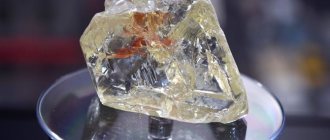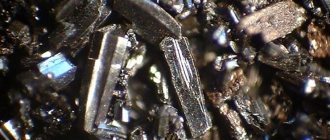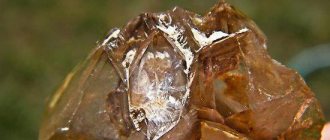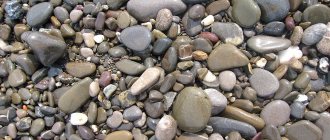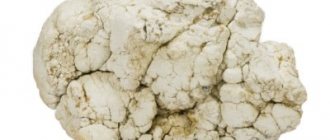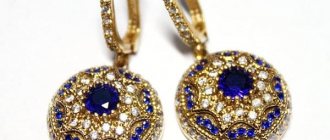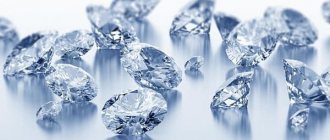Diamond is a mineral that is outstanding in every way. Like an unsightly doll (a nugget diamond really does not look like anything special in appearance), after cutting it turns into a delightful butterfly - a diamond worth hundreds, thousands and even millions of dollars.
But it’s not only the unearthly radiance and fantastic price that makes this stone stand out among its peers. Diamond is the hardest of all minerals, which determines the widest scope of its application. Not every diamond can turn into a diamond - only the purest and largest stones deserve this honor.
But even a small and cloudy nugget will not be thrown away as unnecessary, but will find application in the watch or nuclear industry, quantum computers or microelectronics, and, at worst, in the production of abrasive, drilling and cutting equipment. It's Diamond!
General information about diamonds
Do you know the formula of diamond? Even a preschooler who has no idea about chemistry can remember it. It's just C, which means diamonds are pure carbon (ideally, of course).
What had to happen for carbon to turn into diamond? Many hypotheses have been put forward on this matter. The most convincing of them claims that diamonds are formed at very great depths (over 200 km) and under tremendous pressure - there carbon forms a special cubic lattice inherent in diamonds. During volcanic processes, carbon crystals are carried closer to the surface, where they are discovered by diamond miners.
Gold ring with diamonds (go to the SUNLIGHT catalogue)
This process is very slow: the age of diamonds is measured in hundreds of millions, or even billions of years. So when, during intensive mining, diamond-bearing kimberlite pipes and other rocks are depleted, the reserves of this stone will dry up for a very long time.
According to scientific data, some diamonds are of extraterrestrial origin. They came to us with meteorites or came to us as a result of a supernova explosion. It is assumed that some of them are much older than the solar system!
There are a lot of diamonds on Earth, but only a tiny part of them can be turned into diamonds. The purest and largest diamonds (the so-called “Cape”) are mined in Africa, and Russian reserves of this mineral are concentrated mainly in Yakutia.
Among the most outstanding properties of diamond are the following:
- unsurpassed hardness – 10 on the Mohs scale;
- the highest thermal conductivity among solids – 900–2300 W/(m K);
- vanishingly low coefficient of friction on metal (in air);
- refractoriness and resistance to high temperatures;
- resistance to most aggressive acids and alkalis;
- high refractive index of rays combined with transparency;
- the ability to luminesce (glow) in x-rays and ultraviolet light.
Diamonds are not only white, but also colored. Brown and yellow colors reduce the cost of a diamond, blue, blue, pink, red, green - increase it to sky-high heights.
The main characteristic that decides the fate of a rough diamond is transparency (“clear water”). That is why black diamonds (carbonados) have long been considered exclusively technical. However, occasionally you come across evenly colored black diamonds that retain some transparency and characteristic shine. They are mind-bogglingly expensive.
Diamond formation and deposits
“Mir” kimberlite pipe 525 meters deep
It’s hard to believe, but diamond and graphite are practically twin brothers. Both are pure carbon. In order for graphite to crystallize, special conditions are required: a pressure of 45,000−60,000 atmospheres and a temperature of 900−1300 °C, which are provided at a depth of 80−150 km underground. Together with volcanic magma, stones are ejected from the bowels of the earth, forming primary deposits - kimberlite pipes.
Advertising - Continued below
Scientists also know minerals of meteorite origin, formed during the collision of a cosmic body with the surface of the Earth. The temperature at the moment of impact reaches 3000 °C, and the pressure reaches 100 GPa; under these conditions, diamond-bearing impact rock is formed. “Unearthly” stones were discovered in the Grand Canyon in the USA in fragments of a meteorite that fell about 30 thousand years ago. Yakutia also has its own similar deposit - the Popigai astrobleme, formed 35 million years ago.
The development of impactites is unprofitable due to the small size of the crystals, so industrial mining is carried out using traditional methods in “terrestrial” deposits, which are found on almost all continents, and the largest are located in South America (Brazil), Russia (Yakutia), Africa (Botswana, Angola).
How is the hardness of a diamond measured?
Even a child knows that the strength of a diamond is incredible (meaning its hardness, not its resistance to shock). It is taken as the basic value on all measurement scales. And this is surprising, because diamond’s closest relatives, graphite and coal, which have the same elementary chemical composition, cannot boast of outstanding strength.
The secret of diamond hardness lies in the unique conditions of its formation: high temperatures and incredible pressure. With them, carbon atoms form a unique cubic crystal lattice. This determines the incredible hardness of the final substance, which can exist in natural conditions for billions of years!
Unsurpassed hardness allows diamond to be used in the production of equipment for drilling and ultra-precise cutting. No substance can resist the standard!
Mohs scale
The first successful attempt to create a scale of hardness of materials belongs to the German mineralogist Friedrich Mohs. Despite the fact that this system was presented to the scientific community back in 1811, it continues to be used to this day, mainly in application to minerals of natural origin (including precious stones).
The hardness of a diamond on the Mohs scale is 10, that is, this mineral was taken as an absolute: a priori there is nothing harder than it. The basis of this test is scratching. If a scratch remains on the surface of the test sample, then it is a priori softer than the standard.
The second place in hardness on the classical Mohs scale is held by corundum, which includes sapphires and rubies - 9 points. You can only scratch them with a diamond!
However, the very rare natural moissanite and its artificial analog carborundum (chemical formula SiC) have a strength of as much as 9.5 Mohs points. By the way, carborundum often replaces diamond both in industry and in the production of jewelry. Visually, it is practically indistinguishable from its noble brother, but costs an order of magnitude cheaper!
Everyone knows that diamond has greater strength than graphite, despite the identical chemical composition. However, not everyone knows that they are at diametrically opposite ends of the Mohs scale. The hardness of graphite is comparable to that of talc, and this is only one!
Rockwell system
With the advent of synthetic materials and super-hard alloys, the generally accepted Mohs scale has become inconvenient. Many systems were proposed, but in the metallurgical industry the Rockwell scale (more precisely, the Rockwells, because there were two of them, distant relatives with the same surname) took root most of all.
The Rockwell hardness of diamond is not measured - it is taken as a standard and the main working tool. The Rockwell measuring machine visually resembles a sewing machine, but instead of a needle, a diamond cone is used, and fabric replaces the material being tested.
The sample is exposed to a diamond cone with a given pressure for several seconds, then the parameters of the dent are assessed on a letter-numeric scale.
Types and differences of analogues
Due to the high cost of diamonds, jewelers and manufacturers of electronics and equipment are looking for ways to reduce production costs without sacrificing quality. This is how diamond analogues appeared, making it possible to imitate the shine, hardness and aesthetic component of natural stone.
- Moissanite is a silicon carbide. In terms of its ability to sparkle, moissanite is even 25% ahead of diamond. The stone also refracts colors perfectly and has similar thermal conductivity. Moissanite is inferior only in hardness - 9.25 on the Mohs scale.
- Cubic zirconia or cubic zirconium. Its low cost made it an ideal option for inexpensive jewelry products. The characteristics are significantly inferior to diamond and moissanite.
Also, rhinestones (the cheapest glass option), colorless sapphires, rutile, fabulite, yttrium-aluminum garnet, gallium-gadolinium garnet, zircon, and scheelite can be used as substitutes.
In most cases, the desire to confirm the authenticity of a stone applies to diamonds. When purchasing a product or inheriting jewelry, you want to understand how valuable the purchase is. A diamond is a cut diamond, their properties will be identical, except for trying to see the text through the stone. The cut will prevent you from seeing anything through the stone due to the refraction of light within. Other verification methods are suitable in both cases.
What's harder than diamond?
Many attempts have been made to create or find in nature a material stronger than diamond. So far they have not been successful: obsidan, titanium, super-hard alloys, all kinds of innovative materials cannot compete with the noble standard. Moreover: many chemists and physicists even argue that substances stronger than diamond (more precisely, harder) cannot exist.
The most famous and scandalous story involves a substance called lonsdaleite, which in a chemical and physical sense is a hexagonal diamond. In the 60s of the last century, this mineral was synthesized artificially, and a little later it was discovered in small quantities in meteorite craters.
In 2009, a group of Chinese scientists published a sensational paper claiming that lonsdaleite is more than half as hard as cubic diamond (as we know it). Unfortunately, these data turned out to be a hoax and were not confirmed even by the calculations in the above work.
The most successful attempt to create a substance harder than diamond was made quite recently, in 2022. A duo of American scientists managed to produce hexagonal diamonds from graphite using targeted explosions. The resulting samples demonstrated better sound conductivity than classic cubic diamond, which theoretically indicates greater hardness.
Unfortunately, it has not yet been possible to test the theoretical calculations of American scientists experimentally. And the disgraced lonsdaleite, obtained from graphite by exposure to colossal pressure, shows a strength of only 7-8 points on the Mohs scale. And it’s unlikely to be used: it consists of crystals visible only under a microscope, and obtaining this substance is fantastically expensive.
Gold pendant with cognac diamonds (go to the SUNLIGHT catalogue)
There are other substances that are not much inferior to diamond in hardness: fullerites, all kinds of boron compounds, carbyne, and so on. They are slightly softer than diamond, but often surpass it in other characteristics: strength, resistance to chemical attack and ultra-high temperatures.
A stronger substance can be created from cubic diamond (for example, using nanoengineering). The Japanese succeeded, but how to process this unprecedentedly hard material?
Application of stone
The diamond hardness indicator is also used in industry. Not all stones found in pipes at deposits are suitable for jewelry processing. Most of the material has too many defects. Such minerals are sent to the needs of industry, where diamond is used as an abrasive. Equipment coated with diamond chips works longer and with better quality. Diamond is used in such devices and tools as:
- medical equipment (scalpels, surgical instruments);
- drills, cutters, grinding wheels, glass cutters, scissors and metal saws, drilling rigs;
- in telecommunications and electronics, diamond is used to transmit signals of different frequencies through one cable;
- protective element in the chemical and physical industries;
- the space industry, which even uses lonsdaleite, which is stronger than diamond.
Diamond is a substance that has unique properties. The hardness of the mineral also makes it possible to use it in various fields. The use of stone is relevant, and its value continues to rise. And artificial substances that are stronger than diamond are not yet available for widespread use.
Can a diamond be scratched or broken with a hammer?
Based on the above, we can conclude: it is impossible to scratch a diamond. This makes it possible to quickly identify rough glass counterfeits that are easily scratched by a steel needle or nail file. True, imitation diamonds like cubic zirconia, and even more so carborundum, cannot be recognized in this way.
But there are plenty of substances stronger than diamond - and even steel! This means breaking a diamond is quite possible. Naturally, the stone will calmly survive a fall from a considerable height, and even if you step on it, nothing critical will happen. But if you hit the diamond with force with a hammer, it will crack, otherwise it will crumble into small crumbs.
But you shouldn’t do this: the experiment will be too expensive, and the world will lose another diamond that has been formed over hundreds of millions of years!
19.04.21
Magical and healing properties of diamond
Lithotherapists believe that diamond accelerates the renewal of body cells, promotes cleansing, and fights infections and parasites. In many teachings it is used as a rejuvenating agent.
Advertising - Continued below
Yogis use diamond to treat mental illness, heart, kidneys, and cleanse the liver. Warriors wore diamond rings, believing that it would give them fortitude and make them invincible. In addition, the stone brings happiness to the owner and protects against bad habits and actions.
Use of natural diamonds
On the world market, there are 3 types of diamonds: jewelry (transparent single crystals of perfect shape, weighing at least 0.05 ct, with a small number of inclusions and other defects), subjewelry (with a slightly larger number of defects) and technical. Jewelry and sub-jewelry diamonds cut with a special brilliant cut are called diamonds; the rest are used in technical applications. purposes. A certain amount of jewelry-quality aluminum is also used in technical applications. purposes, mainly in the field of electronics and other high-tech industries (with the ratio of the price of raw materials to the price of a device manufactured on its basis no more than 1:100), but their share is small due to their high cost.

